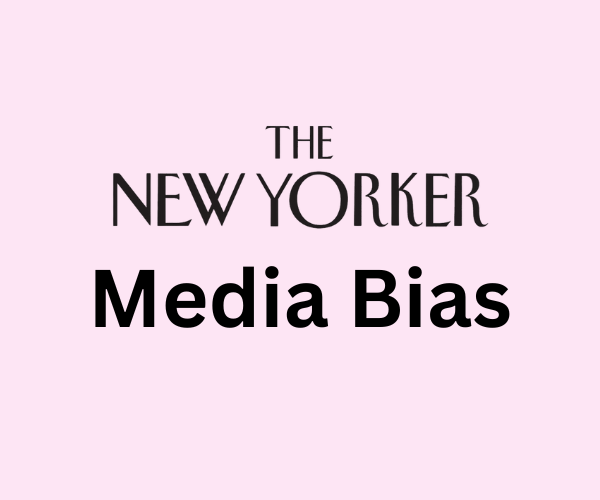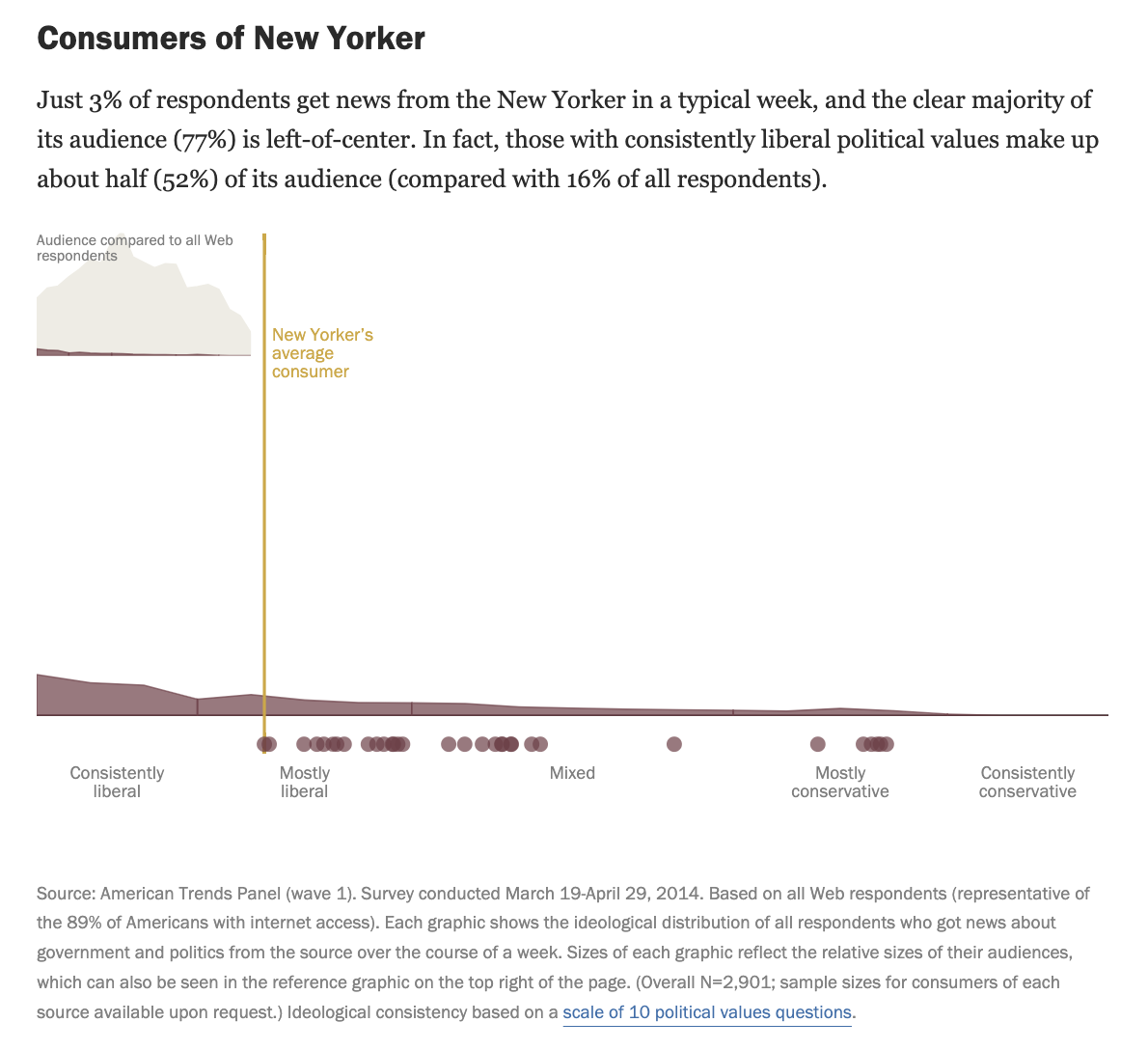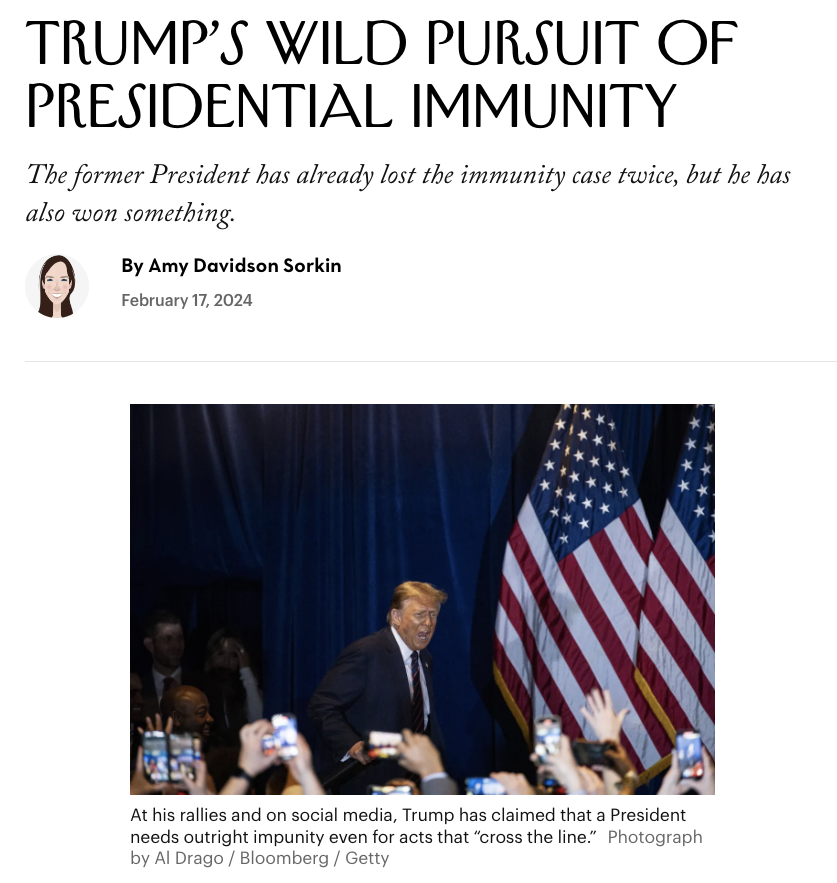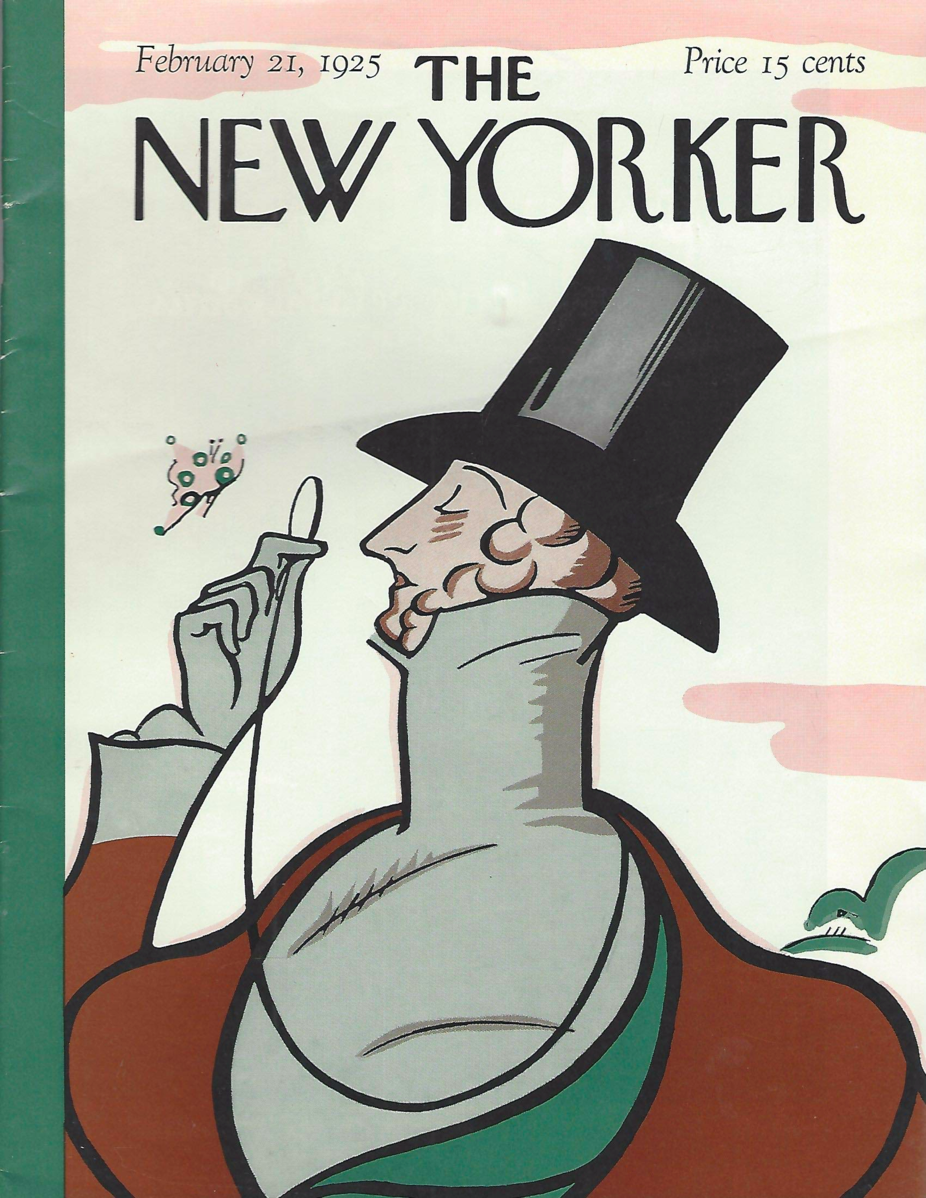
The New Yorker, a best-selling magazine, was founded in 1925 and is based out of New York City, NY. It produces weekly publications, specifically known for its coverage of politics and government. Their articles also include fiction, satire, criticism, poetry, and so forth. The New Yorker focuses on both domestic and global issues, making it relevant to people from multiple cultures and backgrounds. The magazine’s audience tends to hold liberal views. A Pew Research Center survey found that 77% of readers have left-leaning political views, with 52% holding “consistently liberal” political values.

Source: Pew Research Center
How Does Biasly Rate News Sources?
Biasly’s algorithms produce bias ratings to help provide multiple perspectives on given articles. Biasly has analyzed 200,000+ news articles from more than 3,200 news sources through our A.I. technology and team of political analysts to find the most factual, unbiased news stories.
Biasly determines the degree of political bias in news sources by using Biasly’s Bias Meter Rating, in which Biasly’s team analyzes media sources’ reliability and bias and produces three scores, a Reliability Score that measures the accuracy of media sources; an A.I. Bias Score, evaluated by A.I.; and an Analyst Bias Score evaluated by political analysts. These scores are rated based on seven rating metrics including Tone, Tendency, Diction, Author Check, Selection/Omission, Expediency Bias, and Accuracy. These metrics help our analysts to determine the political attitude of the article.
Our A.I. machine-learning system employs natural language processing and entity-specific sentiment analysis to examine individual articles and determine their bias levels. By analyzing the key terms in an article such as policies, bias phrases, political terminologies, politicians, and their nicknames, the algorithms can rate the attitude of the text. Bias scores range from -100% and 100%, with higher negative scores being more liberal and higher positive scores being more conservative, and 0% being neutral.
Is The New Yorker Politically Biased?
The rating Biasly attributes to the New Yorker comes from two scores. The first stems from computer algorithms based on A.I. technology, while the second is developed by trained analysts. Biasly lists both the Computer Bias Score and Analyst Bias score for The New Yorker as being “Medium Liberal.” These ratings assert that the articles covered usually incorporate a liberal perspective. Biasly’s analyst team examines an average of fifteen articles to make this conclusion, but the precision of the scores will increase as more articles are observed. Biasly’s scores are also supported by those of similar third-party bias research agencies, confirming our credibility.
The New Yorker claims that it incorporates several fact-checking procedures in order to publish trustworthy material. In this article, we will examine how they hold up to this commitment.
In 2019, the Columbia Journalism Review wrote that: “no publication has been more consistently identified with its rigorous fact-checking.” An article published by The New Yorker in 2023 states that news sources rely on “the belief that these are groups of people dedicated to pursuing the truth without fear or favor.”
With this in mind, the press is still subject to including different levels of bias in pursuit of the truth. We will observe how The New Yorker includes a left-leaning agenda in its reporting throughout the remainder of this article.
Before we begin, we need to discuss bias. Bias is a natural function of humans, and we can express it both consciously and unconsciously. Bias is one of the most fundamental forms of pattern recognition in humans. This isn’t to lower the bar and say that “all things are biased,” but to explain the process in which we may come to trust certain news organizations that display patterns of coverage.
On the media’s part, there is an incentive to retain audiences, encourage them to purchase subscriptions, and rate products positively. Bias is a two-way street, people want to see news stories about things they care about, and the media needs viewers to continue their operations. This creates a positive feedback loop that influences what stories are covered and from what perspective. This also explains the actions of more liberal news organizations.
Analysis of Bias in New Yorker Articles
53% of the New Yorker’s circulation comes from the top 10 U.S., metropolitan areas. In 2009, Mediamark Research Inc. found the average age of readers was 47. In 2020, 45% of readers were male and 55% were female, with the average household income being $129,631. This grants the assumption that many viewers are educated, middle to upper-class individuals. As the magazine has been determined to be left-leaning, we must keep in mind how age, class, and gender contribute to bias found in New Yorker articles.
Tone, tendency, diction, expediency bias, and author must all be observed when determining bias in an article, and at Biasly we will discuss these metrics in our analyst ratings. The author’s opinion and their aptitude towards one political side over another is reflected in the tone of the piece. Tone also reflects the positive or negative attitude an author has about a topic. Tendency is the consistency in which a particular tone and bias appear throughout an article. Diction encapsulates word choice and whether the author uses inflammatory language to inspire an emotional response. The first impression a reader gains from a headline, image, or description is referred to as expediency bias. Finally, authors must be further investigated to discover how their political affiliations and potential biases are present in their writing. Each of these categories must be analyzed collectively to determine what type and level of bias is included in a news source.
The first article we will look at is “Nine Regular People Tell Donald Trump to Shut Up and Pay Up,” by Eric Lach. Biasly rates this piece as “Center,” but upon further analysis, it’s clear that it incorporates left-leaning sentiments, especially in its description of Donald Trump. The article aims to describe the outcom

“Online, his legions of fans have subjected her to further threats and abuse, for daring to speak out against their supreme leader.”
The author is attempting to describe the treatment Carroll faced after filing charges against Trump, but in doing so creates a derogatory image of Trump’s followers with highly emotive and negatively charged language. This negative tone continues throughout the entirety of the article. When speaking about Trump’s appearance in the courtroom, the author mentions:
“At first, I thought he was attending for the drama so that he could fly to New Hampshire afterward and tell a crowd that he’d come straight from a Manhattan courtroom—and, boy, were his aides tired.”
This again paints a picture that Trump is unprofessional and handling the predicament in a rather unserious way. Trump is also called a “nuisance,” which deliberately sparks a strong reaction among viewers. While the author is entitled to their own opinions on this matter, it becomes problematic when such opinions are disguised as factual reporting. Another such example is when Lach calls the former president a confirmed sexual predator as an outcome of the trial, which is falsified information considering the trial itself focused on the subject of defamation.
“The majority of the people in the room said they hadn’t heard about the case before arriving in the courtroom, even though it involved an ex-president being confirmed as a sexual predator.”
The tendency of this tone is consistent, as the author repeatedly exhibits bias against the Republican Party. Their preference is highlighted through statements such as the following:
“In the meantime, there’s Carroll. She may wind up being a hero in American history. Most people don’t know who she is, but she was once a pretty big deal.”
Again, this is problematic as it detracts from objective, factual reports. Lach alludes that Carroll may be a hero, placing her in stark contrast to Donald Trump and underlining liberal leanings.
Bias is also present in other articles by Lach, such as “Migrant-Crisis Fearmongering Wasn’t Enough to Hold George Santos’s Old Seat”. Expediency bias is immediately present with the use of the word “fearmongering” to express Republican objectives. This piece, rated “Somewhat Liberal” by Biasly, also pushes left-leaning ideologies and expresses a cynical view of the Republican Party and previous congressional candidate Mazi Pilip.
“Pilip had been handpicked by the local Republican Party machine, which has been trying hard to shed its reputation as the gang that brought the world Santos: an incorrigible grifter who managed to get himself kicked out of a Congress otherwise stuffed full of opportunists, conspiracists, manipulators, and insurrectionists, and who is now facing federal fraud charges.”
The diction and tone used are extremely negative, especially with phrases such as “Republican Party machine,” and Congress as being “stuffed full of opportunists, conspiracists, manipulators, and insurrectionists,” when alluding to Republican officials. Lach makes his specific views on Pilip known:
“And yet, despite her life experience, Pilip mostly offered voters the same tired, hateful talking points they can get from any number of white, male Republicans.”
This is another instance of opinion being framed in an objective manner, which has the potential to sway readers toward forming similar views.
Another article to be considered is “One of the Last Abortion Doctors in Indiana”, by Peter Slevin. The tone expressed in this piece is Very Liberal, as confirmed by Biasly’s News Check Chrome Extension. This left-leaning tendency persists throughout the article, articulating many pro-abortion arguments and neglecting to mention alternative views. The author seeks to explain the recent case against physician Caitlin Bernard for violating privacy rules after sharing information about a 10–year-old client she administered an abortion to. During his explanation, Slevin writes:
“The most senior complex-abortion doctor in a state that recently outlawed almost all abortions, Bernard has struggled to balance her work—which involves delivering babies, as well as ending pregnancies—with the fraught task of supporting her patients through medical decisions that increasingly require the advice of an attorney. “Mostly, it’s just incredibly sad,” she told me. “All of these absolutely brilliant clinicians have just spent their entire lives fighting for one basic human right that is literally the easiest procedure that you’ve ever done in your entire life.”
The author frames the issue regarding abortion one-sidedly throughout the work, posing many of the arguments as fact. He continuously supports Bernard, using quotes and diction that inspire sympathy for her situation.
“She said in an MSNBC interview that doctors ‘need to be able to provide this care for everyone, for every single person that we get a call about, from any state all over the country.’ In a column for the Washington Post, she wrote that she felt ‘anguished, desperate, and angry . . . I don’t want to have to accept that a particular religious ideology eclipses my duty as a physician.’”
“Just days after the Dobbs decision, Schwartz told me, Bernard ‘had inherited the poster child of real-life events for the hazards of banning abortion. She had an obligation to let the world know that this fear that we all had—that there were going to be these horrendous situations—actually, truly happened.’”
For reference, Peter Schwartz, who was mentioned in the previous quote, is a PA obstetrician and chairman of the American Medical Association’s ethics council. The author frames Bernard in a positive light and negatively portrays Indiana Attorney General Todd Rokita, who spoke out against Bernard’s actions. Again, the author is privileged to his opinion, but biases must be considered when posting information on a public news source. That being said, it is necessary to more closely observe the personal views expressed in the author’s, Slevin, social media. He divulges some of his liberal biases, particularly relating to abortion, in his X posts and re-posts.
“A victory in Ohio really does tell all of us in the abortion-rights movement that this is possible almost everywhere.” – Kelly Hall, executive director, @FairnessProject @NewYorker https://t.co/g6MKRiNhkp
— Peter Slevin (@peterdslevin) November 10, 2023
Illinois governor J.B. Pritzker on abortion as “the No. 1 issue, not just for Democrats, but in the country” and the prospects of a progressive agenda. @newyorker https://t.co/ckqrzIMWYS
— Peter Slevin (@peterdslevin) October 19, 2023
Among the factors in this week’s decisive vote in Ohio: “the mobilizing power of abortion rights, especially when paired with a message that the bans favored by many Republican-dominated legislatures are an affront to personal liberty.” https://t.co/LQHbWrMc6k
— Peter Slevin (@peterdslevin) August 10, 2023
The three aforementioned pieces include bias toward the left side of the spectrum, but it is still necessary to remember that favor varies between articles and authors. Readers should be aware of the tone, tendency, diction, expediency bias, and author in each report.
Articles with little to no bias from The New Yorker typically cover international news. For example, the piece “What Could Tip the Balance in the War in Ukraine?” by Joshua Yaffa is rated “Center” by Biasly and thoroughly explains the current conflict between Ukraine and Russia. It explains multiple perspectives surrounding funding to Ukraine and does not immediately seem to favor one political agenda.
Analysis of New Yorker Opinion Pieces
To more closely inspect New Yorker opinion pieces, opinion and reporting must be differentiated. News reports are meant to be objective, factual, and unbiased accounts of information from primary sources. This allows the reader to formulate their own ideas based on impartial knowledge. Opinion articles, on the other hand, express an author’s personal views and typically highlight a particular agenda. The New Yorker has a section for reporting and essays, as well as a section for commentary, otherwise known as opinion pieces.
The first article we will observe is “Could a Trump Win Put His Running Mate in Office?” by Jeannie Suk Gersen. This is an interesting piece to analyze, as it is rated by Biasly as “Center,” and covers many objective facts pertaining to Colorado and Maine’s attempt to remove Trump’s name from appearing on the ballot in the 2024 presidential election. Despite this, there are still elements of bias that support a left-leaning agenda. This is made clear in both the opening and closing statements of the article. The author first writes:
“How have we allowed one man to wreak so much havoc on our democracy? Years after Donald Trump was voted out of office, his destructiveness to our electoral system has become so infectious that those who loathe him are doing the work for him.”
The diction and tone create a negative image of Donald Trump and the impact he’s had on the current system of government. In this particular instance, the author is referring to the question of whether states have the constitutional right to bar Trump from the presidency. The article ends:
“If we are headed for a Republican Administration a year from now, for all our sakes, one hopes for the running mate’s.”
This quote refers to the possibility of the vice president taking office if Trump is elected and deemed disqualified by Congress to hold office. It exposes the author’s opinion that they do not support the former president and alludes that it would be dangerous for the country if he were to be reelected. However, as previously mentioned, there are still many factual details included in this article. For example, when discussing a brief written in Trump’s favor, the author explains:
“Authored by Noel Francisco, Trump’s former Solicitor General, and other respected conservative lawyers of the Supreme Court bar, the brief states that, “even if the Colorado Supreme Court were correct that President Trump cannot take office on Inauguration Day,” he is still permitted to run “and also seek removal of any alleged disqualification from Congress if necessary.”
This describes an important detail that is crucial to Trump’s current predicament. It is also worth stating that the author mentions “respected conservative lawyers,” which adds an element of balance to their writing.
The next article we will look at is “Trump’s Wild Pursuit of Presidential Immunity,” by Amy Davidson Sorkin. This piece, rated as “Extremely Liberal” by Biasly’s News Check Chrome Extension, focuses on Donald Trump’s claims to presidential immunity in response to several criminal cases brought against him. Similarly to the last article, the author presents a poor image of Trump.
“If Trump loses his appeal, the Presidency as we know it might, indeed, change in a fundamental way. Contrary to the Trump team’s suggestion, though, it might change for the better; whereas, if Trump gets everything he asks for, it will certainly change for the worse.”
Sorkin is describing how the outcome of the trials would change the limits, or lack thereof, on executive power. Bias is identified in the last sentence, as it states that satisfying Trump’s agenda would be detrimental. Sorkin continues:
“It seems unlikely that a majority, even on this Supreme Court, would accept Trump’s wilder, dictator-like claims.”
While there is adequate background given on the trial proceedings, the author again expresses their dislike for Trump in statements such as these. Expediency bias is also present in the title with the diction “wild pursuit,” and the image chosen portrays Trump in an unflattering manner.

Who Owns The New Yorker?
The New Yorker is a division of Advance Magazine Publishers Inc. The organization is owned by billionaire and business owner Donald Newhouse, who inherited Advance Publications (founded in 1922) from his father, Samuel Irving Newhouse Sr. The company also owns other properties, such as Condé Nast Publications and oversees Vogue and Vanity Fair (which tend to also fall to the left side of the political spectrum).

Cover of the First Issue (1925). Public domain.
How to Evaluate and Uncover Bias
It can often be difficult to tell if the news you watch is biased. If you have settled on a news channel, it’s usually because you trust the information you are gaining. Unfortunately, many trust the information they are hearing because it confirms what they already believe. This is referred to as “confirmation bias.” It is important to challenge your beliefs and get third-party verification that what you are hearing is the full story. This is why we recommend using Biasly to compare different news stories side-by-side using our bias ratings to figure out what both sides think of a political issue.
While Biasly rates The New Yorker as “Medium Liberal,” readers must understand that varying levels of bias will be noticeable in different reports. The New Yorker is capable of publishing centrist articles, but there is a general focus on liberal values and a lack of conservative views. If viewers have any concerns on the bias or reliability of an article, they can utilize Biasly’s News Bias and Reliability Checker.























